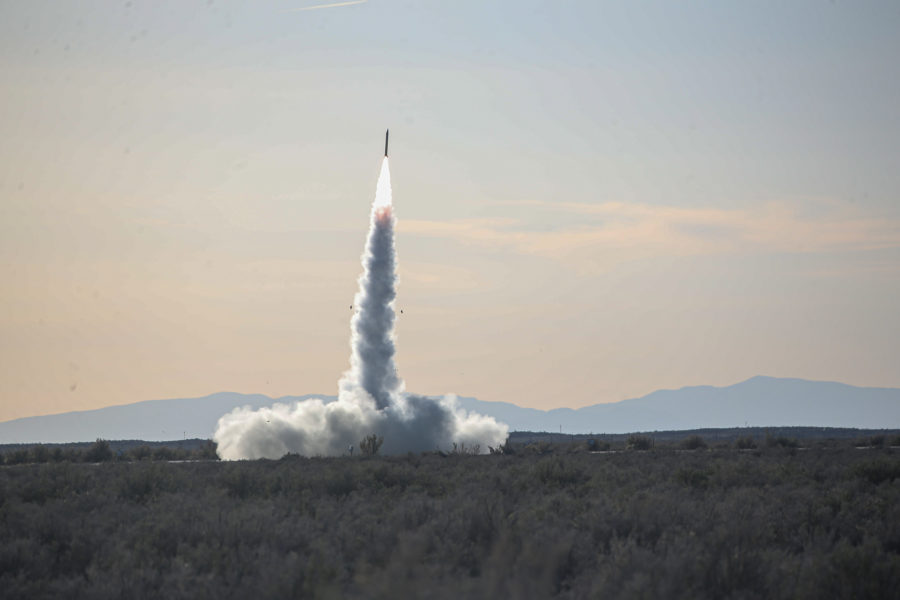While the air picture has remained static in the Russia-Ukraine war, the introduction of High Mobility Artillery Rocket Systems (HIMARS) has allowed Ukraine to strike surface-to-air missile targets behind enemy lines. Now the U.S. is considering future aviation contributions in Ukraine, defense officials confirmed to Air Force Magazine.
Defense officials briefed Pentagon journalists July 29, painting a picture of a demoralized Russian force and a newly empowered Ukraine, able to hold the line thanks to sophisticated new air defenses. A senior defense official confirmed that the United States has facilitated the transfer of “significant spare parts” to keep Ukraine’s Soviet-era MiGs and Sukhois flying, but the Defense Department will not train Ukrainian pilots on new systems until a platform is decided.
“We know that they’ve been able to strike surface-to-air missile locations and to destroy some SAMs,” a senior military official said in response to a question from Air Force Magazine.
“The fact that the Russians continue to not have air superiority certainly says a great deal about Ukrainians’ kind of will,” he added. “Both in their ability to prevent the enemy from shooting at their aircraft, but also to shoot down Russian aircraft.”
The senior defense official said air defense aid has focused on armed unmanned aerial systems, such as the Air Force’s Phoenix Ghost. While Ukraine still retains Phoenix Ghost systems from an earlier defense package, DOD is starting a contracting process to acquire up to 580 additional Phoenix Ghost UASs.
The defense official said in terms of aircraft, the Defense Department is weighing a future contribution.
“Our attention in terms of potential investments in aviation is really much more focused on, kind of, the mid- and long-term than it is on the current fight,” the official said. Lawmakers and Ukrainian Air Force officials have expressed their desire to train Ukrainian pilots on the F-16.
Pressed on why the Defense Department is not inclined to begin training Ukrainian pilots now, the official said that training only made sense after a decision on the future platform is made.
“Well, I think we’re examining this. We’re looking into this question,” the official said. “But really, it is important to identify what the platforms are and will be and make sure that you’re providing the right kind of training.”
American and partner defense assistance, coordinated through monthly meetings of the multi-nation Ukraine Defense Contact Group led by Defense Secretary Lloyd J. Austin III, began in June to provide precise targeting systems that can reach 40 miles behind enemy lines.
The results have stymied the Russian advance.
“They’ve gotten to a point now and created a level of defense that really has the Russians at a standstill. They’ve stopped,” the military official said.
Ukrainian defense minister Oleksii Reznikov has said his country would need “at least 100” more HIMARS to reverse Russian gains in the eastern Donbas region, where Russia now controls the entire Lunhansk oblast and much of Donetsk as well as a land bridge from Russia to the Crimean peninsula, which Russia annexed from Ukraine in 2014.
The United States has delivered 12 HIMARS and has committed four additional systems, while other countries have provided similar systems.
After hitting more than 50 Russian command-and-control sites, ammunition depots, and other targets with the HIMARS, Ukraine began a counter-offensive to take back the key southern city of Kherson, north of Crimea.
Heavy fighting continues, but the U.S. defense officials said little territory is changing hands.
Another powerful air defense system promised by the Biden administration July 1, the National Advanced Surface-to-Air Missile System (NASAMS), which is the same system used to protect Washington, D.C., is still in the contracting process.
Ukrainian officials believe once the system is in place, it can better protect large cities, civilian populations, and key military targets. In recent days, Moscow lobbed missiles at the outskirts of Kyiv and the vital port city of Odesa, despite a Russian agreement not to target port facilities and to allow grain shipments to ease a world food shortage.
Ukraine has argued that it needs air power in the form of modern combat aircraft if it is to truly turn the course of the conflict and regain lost territory. Ukraine and members of the U.S. Congress argue that it is wise to begin training combat pilots now.
The Defense Department, however, is still hesitant to give Ukraine the air power it needs to face modern Russian combat jets and air defense systems.
“Obviously, we want the Ukrainians to have the capabilities they need,” the senior defense official said in response to a question from Air Force Magazine. “Our support to Ukraine in the air domain has been focused on armed UAVs.”

